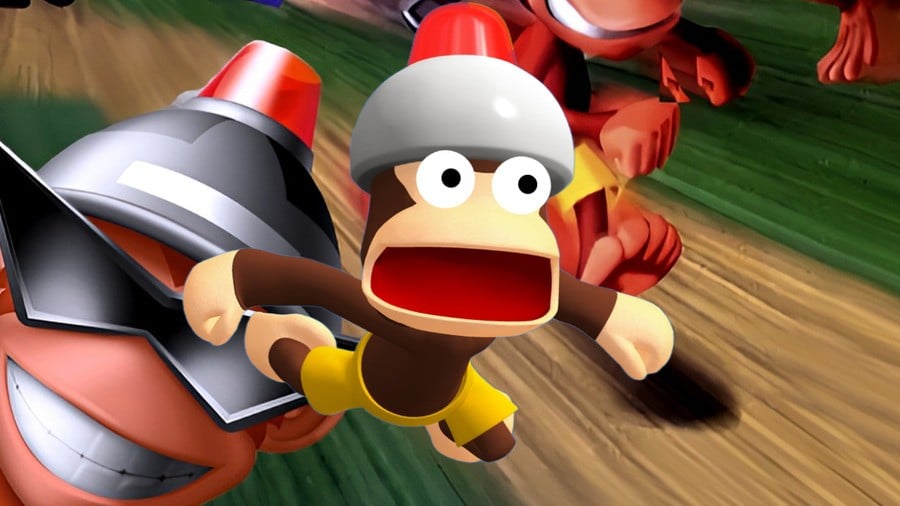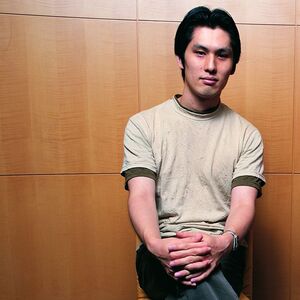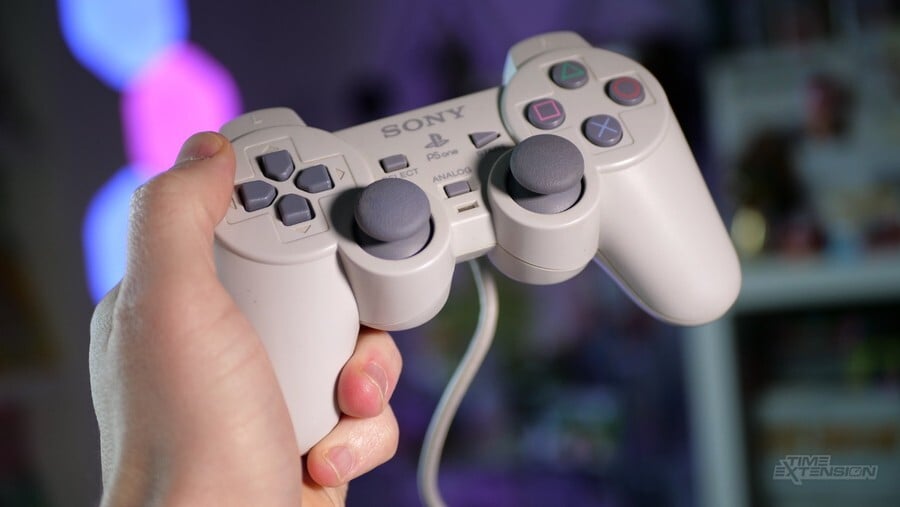
This article was originally published on Monday, May 12th, but has been updated to include additional comments from Soichi Terada, Ape Escape's composer.
Developed as the first game to specifically require the use of the DualShock controller, Sony Computer Entertainment's 1999 platformer Ape Escape (known in Japan as Saru Getchu) was built around a pretty simple yet ingenious premise.
A bunch of mischievous primates have escaped from a lab and have been sent back through time, so it falls to you, the player, to travel across the different eras to recapture them, using the DualShock’s analog sticks as your primary method of control. In the game, players would take on the role of a young boy named Spike (referred to as Kakeru in the Japanese version of the game), having access to an impressive array of toy-like gadgets to track and trap these rampaging simians, with the end goal ultimately being to put a stop to their nefarious ringleader: the evil monkey mastermind, Specter.

Over the years, Ape Escape has gone on to become a beloved franchise in the Sony back catalogue, inspiring several sequels, spin-offs, and guest appearances, as well as merchandise, and other forms of media (comics, manga, and TV shows). But, despite that, interviews with its core development staff are pretty few and far between. As a result, we at Time Extension recently tried to correct this situation, reaching out to a bunch of former Sony Computer Entertainment staff with the help of the Japanese-to-English translator Liz Bushouse. Within hours, we received our first response response, with one of the game's main designers Katsuyuki Kanetaka agreeing to answer some of our questions about the PlayStation classic.
Kanetaka, as far as we're aware, hasn't given a ton of interviews about his time working on the project in the past (at least in English, anyway). In fact, even his MobyGames profile seems to display the incorrect picture (as of the time of writing), showing an image of the game's producer Susumu Takatsuka — something that will only cause more confusion for those researching the original game's development. Nevertheless, he was an important figure in the creation of Ape Escape as we know it today, being responsible (in his own words) for overseeing the following areas of the game:
- Kakeru’s (the player character) behavior
- The gadgets’ behavior
- Settling on Pipo’s Japanese name: Piposaru (lit. Pipo monkey)
- Pipo’s behavior, Pipo’s weapon(s)
- The transition design for all the menu screens and such
- Directing the scenario, script, art, and movie scenes
- Coordinating and ordering the sound effects and BGM
- All the Japanese names for the monkeys and their comments
Because of this, he was more than happy to take us on a trip down memory lane, walking us through the development of the title.
According to Kanetaka, when he first joined the team that was working on Ape Escape it had already been underway for roughly a year, with only two designers having been assigned to the game, Hingo Matsumoto and Kenkichi Shimooka.
As he tells us, neither of these had ever shipped a game before and had been working alongside an equally inexperienced team of part-time college students operating under the watchful eye of the director Susumu Takatsuka (a new hire at SCE who had previously worked at Sega on Virtua Fighter 2 and Fighting Vipers as a 3D CG designer). Soon, though, a decision was made internally at Sony to bring on some more experienced team members, with Kanetaka being among those picked to join the project and help steer the design of the game.
"Before I joined SCE, I was a director on the arcade, PlayStation, and Sega Saturn versions of Street Fighter Zero 2 (Street Fighter Alpha 2) at Capcom," Kanetaka tells Time Extension. "So I had game development experience. That’s why when I joined the team, Mr. Takatsuka moved from being a director to being more of a producer, and I became in charge of a lot of things on Ape Escape.
"All the original development staff were people who didn’t have experience making games. Most of the CG designers were college students doing part-time work, and all the programmers had also just recently graduated from college and joined the company. After that, more people with development experience joined the team, including me and Kazuo Kato (who was a programmer). A good thing that came from that was that the inexperienced people were a lot freer with their ideas, so we had a good mix of suggestions."
All the original development staff were people who didn’t have experience making games. Most of the CG designers were college students doing part-time work, and all the programmers had also just recently graduated from college
Reflecting on what the project looked like when he first came on board, Kanetaka tells us that it focused on a young boy "about 18 years old" who swung a cudgel and ran around a field fighting gorilla enemies. As he tells us, one of the gadgets, the Sky Flyer, already existed, but the original designers had yet to come up with the idea of chasing monkeys around the map to catch them with a net — something that would become a key component of the game later on.
Instead, as he informs us, it was only after the developers realized that the 3D environments they were designing were potentially confusing and easy to get lost in that the team began suggesting ideas for a bunch of animals to chase around, believing this could serve as a clear objective to help the players navigate the game's large, open areas.
According to Susumu Takatsuka in a PSM Magazine interview published in July 1999, various animals (including lions and tigers) were initially considered as the creatures that the player would be chasing around, but eventually, it was decided to focus exclusively on monkeys, due to the popularity of the initial "Pipo" character designs and 3D models, created by the artist Takamitsu Iijima.
"Unlike the 2D games that had been released up until that point, the space in 3D games offered way too much freedom," Kanetaka recalls. "And it became very easy for players to lose sight of what they should be doing or where they should be going. So we talked about creating something to chase, to make it clear to the player where they should go and what their objective is. We ultimately decided that it would be good to chase a monkey that’s running around and provoking you. Shimooka came up with that idea. We then talked about having something on the monkey’s head, so that you could easily pick it out even from far away, and so Iijima designed Pipo['s helmet] with that in mind."
We ultimately decided that it would be good to chase a monkey that’s running around and provoking you. Shimooka came up with that idea.
Interestingly, when Kanetaka first joined the project the team was originally designing the game to feature a much more conventional control scheme. That, however, apparently changed after Sony revealed the DualShock controller to the team ahead of the device's initial launch back in 1997, causing them to rethink how they could take advantage of its new features, including the dual analogue sticks that had been missing from the original PlayStation controller.
How this eventually ended up being implemented in the finished game is that players use the left analog to maneuver the character around, while the right stick would be in control of the various gadgets you've unlocked on your journey (the Stun Club, Time Net, Monkey Radar, Slingback Shooter, Dash Hoop, Sky Flyer, R.C. Car, and Magic Punch).

To select a gadget, players would need to use the PlayStation's face buttons (Triangle, Square, Circle, Cross) to toggle between the available options outlined on the upper-right-hand side of the screen, while the R1 & R2 triggers were both reserved for jumping. L3, meanwhile, enabled you to crouch, allowing you to sneak up on unsuspecting monkeys without arousing any unwanted attention.
"We had a difficult time figuring out how the player should control gadgets," says Kanetaka. "But with the stun club, we got the idea of pushing the joystick in a direction to have Kakeru face that way and swing the club, which solved everything. The programmer Yuji Yamada-san’s idea for controlling the slingback shooter served as an inspiration for that."
As he states, no gadgets ended up being cut prior to the game's final release, but the dash hoop was almost removed, he tells us, because no one could come up "with any ideas for what ability it would have". Fortunately, though, someone on the team eventually did develop a concept for the unusual device, suggesting that it would be cool for the gadget to make you run faster, with the trade-off being that it would be slightly more "difficult to control."
In total, the original Ape Escape ended up featuring 8 unique zones for players to explore. This included The Lost Land, Mysterious Age, Oceana, New Freezeland, Medieval Mayhem, Futurama, Specter Land, and Dimension-X. Most of these zones contained 3 levels each and had players jumping, crawling, and gliding across a wide range of different terrains and climates, from frozen tundras to dense jungles, futuristic cities, and medieval castles, to track down the missing monkeys.
In addition to this, there were also a couple of bonus vehicles situated within some of the game's levels that you could pilot (including a raft and a tank), as well as golden coins that could be collected to unlock additional minigames available from the game's hub world (skiing, boxing, and a twin-stick shoot 'em up).
Of course, we couldn’t talk about Ape Escape though, without also mentioning the music. And luckily, for us, after speaking to Kanetaka, the game’s composer Soichi Terada replied to our message, agreeing to answer some questions about his involvement in the project.
Before joining the Ape Escape team, Terada had been a successful solo musician in Japan, specializing in electronic house music, and a producer for other artists. He had begun working in video games at the insistence of his agent, with one of his earlier efforts being the music for the PlayStation title Wangan Trial from Tose Co. Ltd and Victor Interactive Software, which saw players competing in races to unlock cutscenes stories about five different girls.
According to him, his involvement with Ape Escape had come about as one of the higher-ups on the project (either Takatsuka or Takafumi Fujisawa, a member of Sony Computer Entertainment’s sound group) had been listening to his solo drum & bass album 'Sumo Jungle', and felt it would fit the direction of the music.
Speaking about his involvement with the series, he states, "I think it was 1997 when I had the first meeting for the production of Ape Escape. There were 2 directors (Kanetaka-san and Takatsuka-san) when I joined as I remember. I was so happy to know that there were [people on the team] listening to Sumo Jungle.
"The directors told me that Kakeru/Spike and his friends are always running so songs with high-speed tempos would be the perfect fit for the characters. So I ended up writing many tracks in that style."
As Terada-san tells us, when he first became involved with the project, he initially didn't have much knowledge about what the game actually looked like, as files for movies were too large to send over the internet. As a result, he wrote much of the music early on based on general descriptions from the team, only occasionally seeing the odd bit of footage every month to give him an idea of whether or not he was heading in the right direction.

Late into the development, he was able to get his hands on a debug station temporarily to get some firsthand experience of what the game was like to play and remembers occasionally getting distracted from his work, thanks to exploring the 3D worlds with the free-camera setting included in the early build.
According to Terada, at the time, his favourite piece of equipment to write music on was the Akai S1000 digital sampler, which he would use alongside an NEC computer and a bunch of synthesizers he had at his disposal. How it would work is he would write the music, and then he would meet up with the development team to work on getting the compositions into the game.
"As you might know, the soundtracks were not recorded but played by MIDI data with a SPU custom sound module song by song to reduce the data size for the soundtracks," Terada tells us. "I was working with the sound designer and he translated the songs into those formats song by song after approval of the trial song by the director."
As he tells us, it was during these conversations with the team that some of the fun interactivity of the soundtrack was born, with Takatsuka and others suggesting ideas to make the music more playful. This includes having the drum & bass cut out when entering a sneaking mode.
"I remember that idea came from Takatsuka-san," says Terada. "There was also a suggestion for a stage without a soundtrack until the player hit the big button, and that was an idea that I think came from Kanetaka-san."
When Ape Escape was finally released for the PS1, it ended up becoming a huge success for Sony's internal development team, quickly winning over critics thanks to its innovative controls, fun-to-use gadgets, and charming sense of humour. IGN's Doug Perry, for instance, described the game at the time as "the best 3D platform game on the PlayStation. Hands down", while Next Generation argued that it was “ideal for younger players” and would even appeal to "the most jaded [of] hardcore players”.
It has since gone on to receive several sequels and spin-offs, as well as a remake for the PSP, called Ape Escape: On the Loose! (or Ape Escape P, as it was known in Europe). That's in addition to three separate TV shows: Shogakukan Music & Digital Entertainment's Ape Escape (2002), the CGI-anime Saru Getchu -On Air (2006), and Frederator Studios' Ape Escape (2009).
Right now, however, the series seems to be experiencing a lengthy hiatus, having not received a brand-new entry since 2010's PlayStation Move Ape Escape. Instead, fans have had to make do with cameos and references in other Sony-related projects, with the Pipo Monkeys most recently turning up in Team Asobi's Astro Bot and also being announced Snake Vs. Monkey (an additional mode in Konami's upcoming Metal Gear Solid 3: Snake Eater remake: Metal Gear Solid Delta for PlayStation 5 and Steam).
With Sony announcing, in 2021, that it would be restructuring Japan Studio (the successor to the original Ape Escape developer) to focus on Team Asobi, it has left many fans fearful for the series's future beyond appearances in other games. But Terada has hope that an Ape Escape 4 could still one day exist, and would love to be a part of it.
"It will be difficult because of the dissolution of Japan Studio several years ago," Terada tells us. "But I hope that a group can produce it someday. If possible, I would like to contribute one track, like the theme of "Ape Escape 4, if I could not be involved entirely. Though it would be perfect to make all of the soundtrack."



